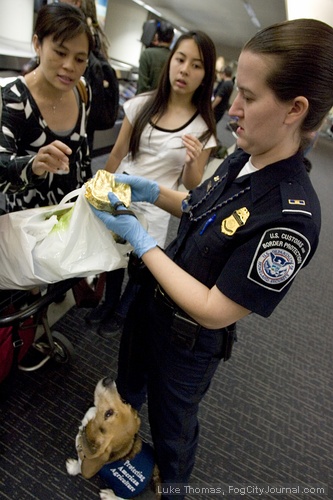
Protecting U.S. agriculture, customs Inspector Carla Blackmon
and her canine teammate, Chip, work the international baggage claim area
of San Francisco International Airport to interdict contraband.
Photos by Luke Thomas
By Emmett Berg
January 21, 2008
They barely made it to their baggage carousel in the International Terminal by the time the Feds closed in with a K-9 team. And within moments the targets coughed up their contraband. In the wake of the bust other passengers tossed stashes right onto the floor, leaving behind plastic bags no one would claim for fear of Chip, a U.S. Customs and Border Protection beagle.
As a last line of defense against disaster, a beagle may not be your first choice. Yet Chip and other K-9 beagles in use at San Francisco International Airport are considered indispensable to authorities as they seek to protect against entry of exotic pests and plants from foreign countries that could devastate California agriculture.
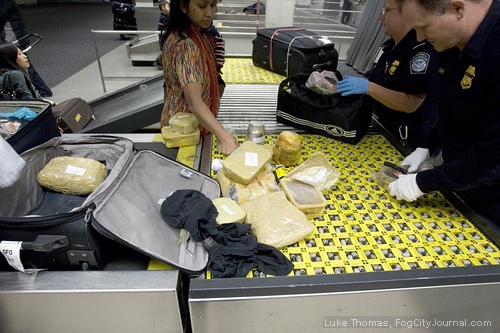
Better in crowds than bigger dogs, beagles’ lineage as scent hounds makes them ideal for the task. On January 16, Chip and his handler, Inspector Carla Blackmon, were confiscating oranges from giggling school girls arriving on a flight from Singapore. That may seem like small potatoes, but in the same week beagles helped confiscate potentially tainted beef from Japan and other items containing trouble of the microscopic kind.
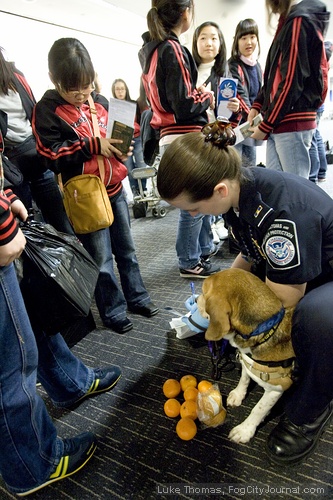
Blackmon and Chip detect oranges
in the carry-on-luggage of a group of Singaporean school girls.
The problem of exotic species entering America, whatever the intent of the bearer, is constant and demonstrable. Agricultural inspectors with the U.S. Customs and Border Protection service in Oakland in November found tiny pests never before seen in America that were living inside bamboo sticks shipped over from China. In Denver last fall, inspectors found an exotic live slug inside grape leaves and beef products that went undeclared before being discovered.
Gone undetected, either pest may have the potential to wreak havoc in the form of lost harvests, disease, and other damage. When Mediterranean fruit flies, or medflies, were discovered in California in 1982, the widespread eradication effort that followed — including massive use of pesticide and National Guard troops at checkpoints — became controversial even as farmers warned that billions of dollars of crops might be lost. And 25 years later, medfly larvae are still being discovered in California.
Despite the risk, some travelers are more than willing to bend the rules to bring in prohibited items, which vary depending on the country of origin. Prepared foods from Great Britain like a steak-and-kidney pie are deemed unsafe due to the outbreak of foot-and-mouth disease in that country in 2001, and beef from Germany is another no-no. Similarly, officials deploy K-9 beagle teams when passengers disembark from flights originating in Vietnam, Laos, China and the Philippines due to the high incidence of banned items — sometimes dozens of plants in a single suitcase.
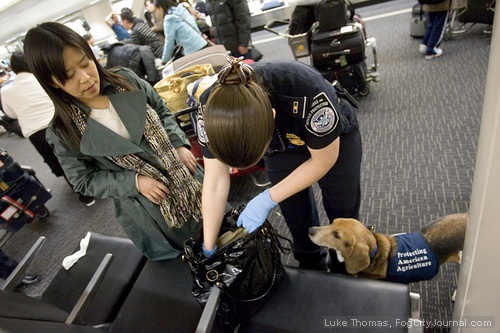
Often, travelers simply want to share the foods and plants from their home countries, or delicacies that are hard to find locally. Fruits like mangosteens from Asia, or mamey sapote from Mexico or South America, are routinely detected and confiscated. Less common are the tales of determined travelers, one who hid live parrots inside a stereo boom box outfitted with an internal fan controlled by the volume knob, or the woman who pretended to be pregnant as a ruse to smuggle in a watermelon.
To become a handler, a previously trained agricultural inspector will spend 10 weeks with their K-9 partner at the National Detector Dog Training Academy in Orlando, Florida before fanning out nationwide for airport deployment. Most handlers have educational backgrounds in animal science and self-identify as dog people. As Blackmon says, “It’s kind of hard to work a dog if you don’t like dogs.”
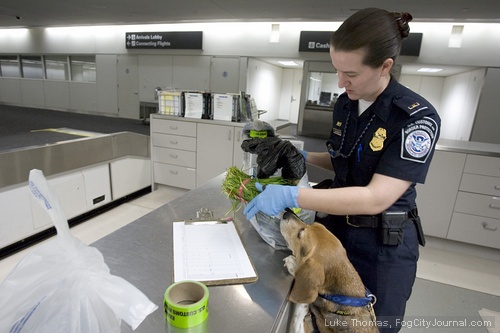
Chip and other beagles maintain a 95 percent proficiency rate during training and are tested yearly for their ability to sniff out five basic scents: pork, beef, apples, citrus and mango. Trainers will mock up luggage with items commonly found in travelers’ bags from different regions of the world, and put the beagles to the test. With the onset of avian flu the dogs have also been trained to identify poultry.
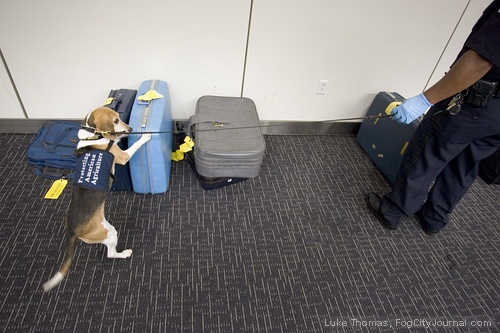
One of Chip’s canine co-workers indicates with his paw a suitcase containing a mango.
But sniffing food and doing it right take time: Blackmon has worked extensively with Chip so he won’t destroy luggage or become too aggressive. “Chip has this nickname — ‘The Incredible Hulk’ — but he’s a lot better now,” Blackmon says. The correct way for the beagle to signal a “hit” is to sit, and if prompted, place a paw on the offending bag. In practice the handlers are keen to any distinct change in behavior.
Giving of treats is also harder than it looks. If a handler fails to give the beagle a treat immediately upon discovery of a problem bag, the dog may construe that as a signal not to sniff out such bags. “The dogs aren’t the only ones who need to be well-conditioned,” Blackmon says.
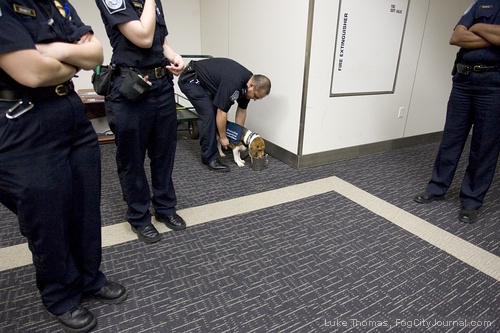
Thirsty work: Contraband detecting beagles work 3-hour shifts.
There are a total of 86 beagles working at SFO and other airports across the nation, and most were not groomed for the job since birth. Many are rescued from homes where they didn’t fit in. As a result, not all are poddy-trained or easy to direct, but in time they fall in line. And the perks of the job include regular veterinary care, “retirement” after nine years of service in the form of adoption, and treats every time they sniff out a problem.
Health care for the beagles continues even if they leave service — one received treatments for cancer — and their wellbeing is treated seriously. The airport environment is hazardous for beagles, subject to runaway luggage carts and groggy travelers. And there are some who lash out at the dogs despite it being leashed to a uniformed customs inspector. A person who kicked a beagle in 2000 led to passage of a federal law establishing a maximum $10,000 fine for abuse of beagles and other “detector” dogs working in an official capacity.
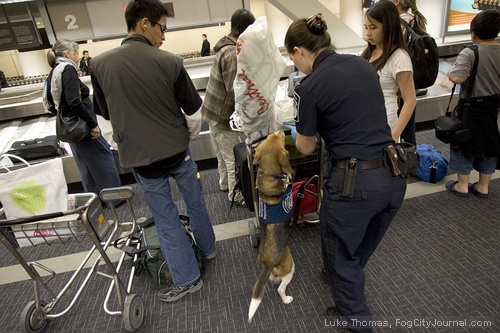
“People don’t realize sometimes and are startled by the dogs, and others just go and freak out,” said Inspector Peter de Souza, a K-9 handler who works with Blackmon and other inspectors at SFO. “Every day we train the dogs not to touch anybody, and every day we have to remind people not to touch the dogs.”
It’s all serious business — until the day is over. When Chip completed his shift, Blackmon removed Chip’s blue top coat and Chip took the opportunity to roll onto his back to expose his belly for a few rubs. Then he stuck one paw out and propelled himself upside-down across the floor. “He would do this all day if I let him,” she said.

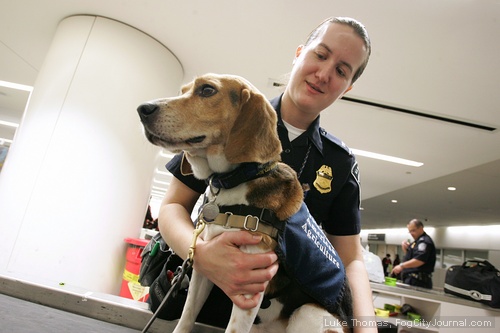


 The Hunger Site
The Hunger Site
No Comments
Comments for The Beagle Brigade: Stopping Entry
of Harmful Pests, Plants and Foodstuffs are now closed.